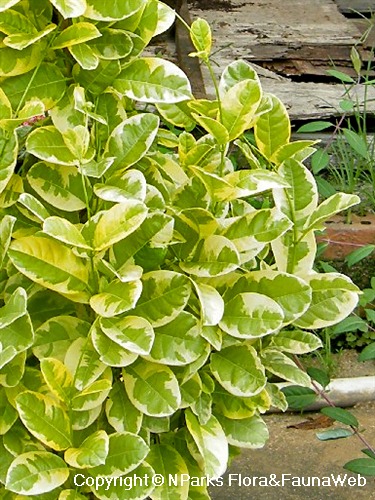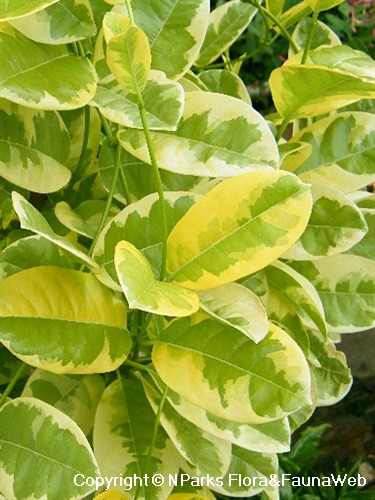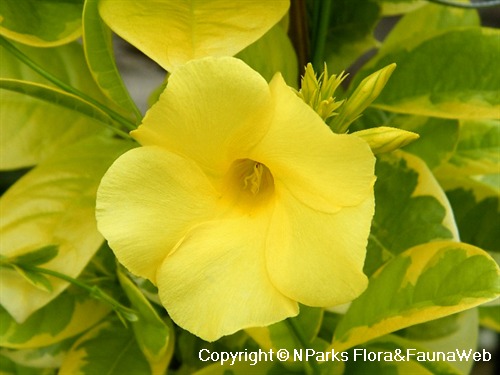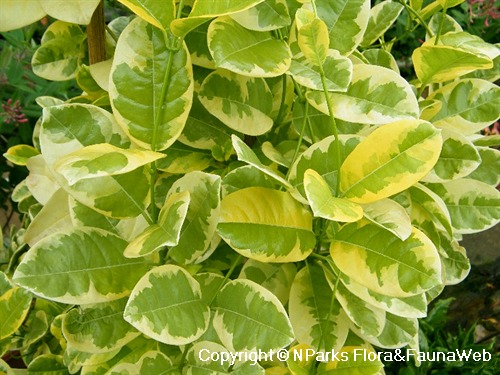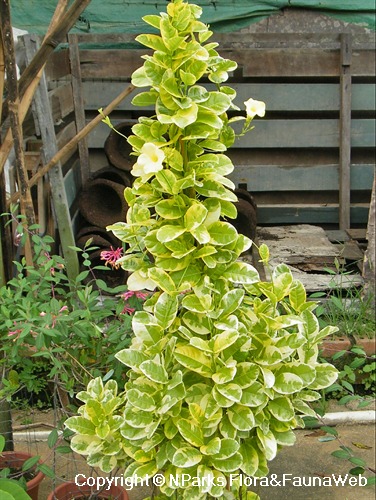
Back
Pentalinon luteum (L.) B.F. Hansen & Wunderlin (yellow-cream-green leaves)
| Family Name: | Apocynaceae |
| Synonyms: | Urechites lutea var. sericea cultivar, Pentalinon suberectum (cultivar), Vinca lutea (cultivar), Urechites pinetorum (cultivar), Urechites lutea (cultivar) |
| Common Name: | Variegated Hammock Viper's-Tail, Variegated Wild Allamanda, Variegated Yellow Mandevillea, Variegated Lice Bush |
Name
Classifications and Characteristics
| Plant Division | Angiosperms (Flowering Seed Plants) (Dicotyledon) |
|---|---|
| Plant Growth Form | Shrub, Climber |
| Lifespan (in Singapore) | Perennial |
| Mode of Nutrition | Autotrophic |
| Plant Shape | Irregular |
| Maximum Height | 1.8 m to 2.4 m |
| Maximum Plant Spread / Crown Width | 3.0 m |
Biogeography
| Preferred Climate Zone | Tropical |
|---|
Description and Ethnobotany
| Growth Form | Scrambling woody vine, up to 2.4m height with support, climbing over structures or other plants. Scandent and shrub-like when young. All parts of plant exude a sticky white latex when bruised. |
|---|---|
| Foliage | Broadly-elliptical, glossy, with light green centres and irregular yellow or cream margins. |
| Flowers | Bright yellow, funnel-shaped, produced throughout the year. Some flowers are always present on the plant, although the blooming is not as exuberant as its Allamanda relatives. |
| Similar | Colourful-leaved version of the species form Pentalinon luteum, which in turn is a smaller and less aggressive alternative to the lookalike Allamanda cathartica (Golden Trumpet). Flowers of the species form are known to be a nectar source for various Skipper and Sulphur butterflies in the plant's native range (USA Florida to Central Amercias). Species form is also a host plant for the caterpillars of several day-flying wasp moths. |
| Cultivation | Provide well-drained soils. Tolerant of low fertility and moderate salt spray. Prune regularly to control shape and size. Milky latex is toxic upon ingestion. Handling of the plant may cause skin irritaion in sensitive individuals. |
| Etymology | Genus epithet 'Pentalinon' derived from Greek terms 'penne' (five) and 'linon' (rope), a reference to the elongated flower anthers found in members of this genus. Species epithet 'luteum' means 'yellow', alluding to the colour of the flowers. |
Landscaping Features
| Desirable Plant Features | Ornamental Foliage, Ornamental Flowers |
|---|---|
| Landscape Uses | Vertical Greenery / Green Wall, Flowerbed / Border, Hedge / Screening, Container Planting |
| Thematic Landscaping | Golden Garden, Butterfly Garden, Naturalistic Garden |
| Usage Hazard - Cons | Toxic Upon Ingestion |
Fauna, Pollination and Dispersal
| Fauna Pollination Dispersal Associated Fauna | Butterfly-Attracting |
|---|
Plant Care and Propagation
| Light Preference | Full Sun |
|---|---|
| Water Preference | Moderate Water |
| Plant Growth Rate | Moderate |
| Rootzone Tolerance | Fertile Loamy Soils, Well-Drained Soils |
| Maintenance Requirements | Moderate |
| Propagation Method | Stem Cutting |
Foliar
| Foliage Retention | Evergreen |
|---|---|
| Mature Foliage Colour(s) | Cream / Off-White, Green, Yellow / Golden |
| Mature Foliage Texture(s) | Smooth, Glossy / Shiny |
| Foliar Type | Simple / Unifoliate |
| Foliar Arrangement Along Stem | Opposite |
| Foliar Shape(s) | Non-Palm Foliage (Elliptical) |
| Foliar Venation | Pinnate / Net |
| Foliar Margin | Entire |
| Foliar Apex - Tip | Acute |
| Foliar Base | Rounded / Obtuse |
| Typical Foliar Area | Mesophyll ( 45cm2 - 182.25 cm2 ) |
Non - Foliar and Storage
| Stem Type & Modification | Woody |
|---|---|
| Root Type | Underground (Fibrous Root) |
Floral (Angiosperm)
| Flower & Plant Sexuality | Bisexual Flowers |
| Flower Colour(s) | Yellow / Golden |
|---|---|
| Flower Symmetry | Radial |
| Individual Flower Shape | Funnelform / Funnel-shaped |
| Flowering Habit | Polycarpic |
Image Repository
Others
| Master ID | 29689 |
|---|---|
| Species ID | 3998 |
| Flora Disclaimer | The information in this website has been compiled from reliable sources, such as reference works on medicinal plants. It is not a substitute for medical advice or treatment and NParks does not purport to provide any medical advice. Readers should always consult his/her physician before using or consuming a plant for medicinal purposes. |


